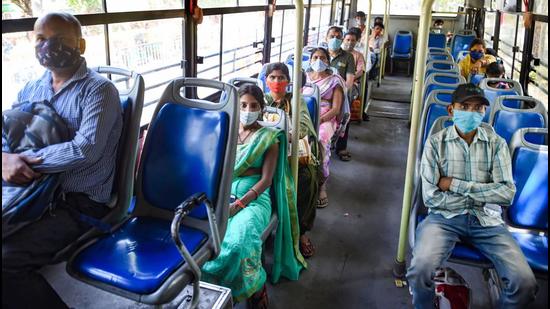Covid-19: The future is here
The patterns have been predictable for a while. In any susceptible population that is not making strong efforts to reduce transmission, SARS-CoV2 will rapidly transmit with exponential growth until a combination of recovered people with immunity and heightened precautions slow the spread
The future is already here, it is just not very evenly distributed. These memorable words, by William Gibson, come to mind as I think about the course of the pandemic and consider what lies ahead. A variety of scenarios has unfolded around the world, the differences attributable to a combination of agency, constraints, and sometimes luck. However, the patterns have been predictable for a while.

In any susceptible population that is not making strong efforts to reduce transmission, SARS-CoV2 will rapidly transmit with exponential growth until a combination of recovered people with immunity and heightened precautions slow the spread. This sequence of rapid rise, peak, and fall happens over about six to eight weeks in a city, during which health care systems get stressed and preventable deaths mount.
The wave is broader for a large state or a country, being composed of smaller narrower waves occurring after each other, but is again predictable. This is what was seen all over the world during the first wave. India had the privilege of seeing this course of events in other nations and prepare, which limited our losses.
It was equally clear from the rest of the world, especially the United Kingdom (UK) and Brazil, that the first wave was not the last. Immunity declines, the virus mutates to escape the immune pressure, and precautions melt away — setting the stage for new waves of explosive growth in freshly susceptible populations that are making only token efforts to reduce transmission. Recovered people show 20-30% decline in their virus neutralising immunity by six months, based on data from the CSIR serosurvey, now published in eLife.
Also Read | Why is India seeing Covid-19 second wave? AIIMS chief Randeep Guleria explains
Mutations of the virus make it able to evade what little immunity remains. The INSACOG sequencing consortium data clearly shows that not only have we seen explosive growth of imported variants, such as the B.1.1.7 UK variant, in Punjab, but have also had emergence of local variants such as B.1.617 in Maharashtra. The latter, with 15 lineage defining mutations, and two immune escape mutations — E484Q and L452R amino acid changes in the spike protein at sites important for antibody neutralisation and virus entry into cell — is worrisome.
At a molecular level, these mutations make the virus more transmissible and able to evade immunity, potentially causing larger outbreaks and reinfections. Unlike B.1.1.7, where there is adequate vaccine data from UK to be confident that vaccination will prevent severe disease, we are yet to fully learn about the properties of B.1.617. Due to INSACOG efforts, I expect these answers to be available soon.
Meanwhile, it does not seem that there is any significant increase in severity, although we have seen many more young infections this time. This may simply be because the outbreaks were in schools and colleges, unlike the first wave. The necessary public health measures remain exactly the same and the mask as vaccine concept stays important. This needs to be implemented more seriously and in a sensible manner. To be fined for not wearing a mask alone in one’s car, while masks are absent in crowded markets, makes little sense.
Finally, we need to overcome vaccine hesitancy, with a clear understanding that infections will occur even after vaccination. They will just be fewer, milder and transmit less. The total lives lost to Covid-19 will drop drastically, if we combine basic precautions with vaccination.
From a scientific standpoint, I see the glass as half-full. The identification of the indigenous variant has occurred in a timely manner, based on molecular filters, with correlation between the increase in variant and the rise in cases. There remains much room to improve the ecosystem, such that genomic findings are better integrated with clinical actionability. My institute’s direct experience working with the Kerala government suggests that this is very much possible when all stakeholders come together.
Also Read | Sanjay Raut blames Centre for rising cases in Maharashtra, Chhattisgarh, Punjab
One question that I get asked often is whether India is sequencing enough. My half-answer is that it depends on what we plan to do with the data. At a basic level, we sequence to stay abreast of the changes to the virus, so as to predict implications on vaccine efficacy and the expected trajectory of the pandemic. Some mutations, such as the E484K in South Africa (B.1.351) and Brazil (P1) variants, make the virus capable of escaping vaccine induced antibodies. In Bangladesh, B.1.351 has reached 80% of samples tested.
As of March 2021, we have also seen a progressive increase of immune escape variants in Indian samples, including indigenous E484K mutants, but at a lower fraction. This is akin to seeing the future through events unfolding in our geographical vicinity, in a population similar to ours. Similarly, the outbreaks and rise of B.1.1.7 in Punjab, will surely be paralleled in neighbouring states in the natural course of events. The same story is currently being repeated in multiple parts of the globe. Our ongoing sequencing efforts have thus already provided warning signals for urgent public health preparedness and mobilisation.
I now look forward to the next stage of this effort with faster and more comprehensive sequencing, combined with better clinical correlation, viral research, and timely public health action. The hope is not to just see the future, but to shape it.
Anurag Agrawal is director, Institute of Genomics and Integrative Biology (Council of Scientific and Industrial Research)
The views expressed are personal






